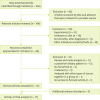Index-Based Dietary Patterns and the Risk of Prostate Cancer
- PMID: 29124044
- PMCID: PMC5665745
- DOI: 10.7762/cnr.2017.6.4.229
Index-Based Dietary Patterns and the Risk of Prostate Cancer
Abstract
Prostate cancer is the second leading cause for cancer incidence in male. Although this high incidence is due to prostate specific antigen screening, other risk-factors, such as diet, might also be involved. The results of previous studies on the association between prostate cancer risk and individual dietary components have been conflicting. Thus, evaluation by dietary pattern analysis rather than individual dietary factors is suggested. The purpose of this study was to review the association of prostate cancer with a priori dietary indices, which are less studied and reviewed to date compared to a posteriori indices. Studies reviewed in this research were published from January 1997 to March 2017. Seventeen studies with nine indices were selected. In Mediterranean Diet Score (MDS), all four studies were non-significant. In Dietary Inflammatory Index (DII), 3 out of 4 studies significantly increased risk by 1.33-2.39 times, suggesting that a higher pro-inflammatory diet may be a possible prostate cancer risk factor. In Oxidative Balance Score (OBS), 2 out of 5 studies had decreased risk by 0.28 and 0.34 times, whereas 1 study had increased risk by 1.17 times. Among other indices, Healthy Eating Index (HEI) and prostate cancer dietary index were associated with decreased risk, while the results from 2 studies of Low Carbohydrate, High Protein Diet (LCHP) score were conflicting. In conclusion, we observed that it is insufficient to support the association between a priori indices and prostate cancer risk, except for MDS and DII, which had relatively constant results among studies. Therefore, further studies are required to identify consistent criteria for each a priori index, and should be conducted actively in various populations.
Keywords: A priori dietary pattern; Dietary inflammatory index; Mediterranean diet; Oxidative balance score; Prostate cancer.
Conflict of interest statement
Conflict of Interest: The authors declare that they have no competing interests.
Figures
Similar articles
-
Dietary Inflammatory Index is associated with Healthy Eating Index, Alternative Healthy Eating Index, and dietary patterns among Iranian adults.J Clin Lab Anal. 2020 Dec;34(12):e23523. doi: 10.1002/jcla.23523. Epub 2020 Aug 27. J Clin Lab Anal. 2020. PMID: 32856354 Free PMC article.
-
Index-based dietary patterns in relation to gastric cancer risk: a systematic review and meta-analysis.Br J Nutr. 2020 May 14;123(9):964-974. doi: 10.1017/S0007114519002976. Epub 2019 Nov 26. Br J Nutr. 2020. PMID: 31767045
-
Anti-inflammatory Dietary Inflammatory Index scores are associated with healthier scores on other dietary indices.Nutr Res. 2016 Mar;36(3):214-9. doi: 10.1016/j.nutres.2015.11.009. Epub 2015 Nov 14. Nutr Res. 2016. PMID: 26923507 Free PMC article.
-
Associations between dietary inflammatory index and incidence of breast and prostate cancer: a systematic review and meta-analysis.Nutrition. 2018 Nov;55-56:168-178. doi: 10.1016/j.nut.2018.04.018. Epub 2018 May 25. Nutrition. 2018. PMID: 30086486
-
Index-Based Dietary Patterns and the Risk of Prostate Cancer among Iranian Men.Asian Pac J Cancer Prev. 2019 May 25;20(5):1393-1401. doi: 10.31557/APJCP.2019.20.5.1393. Asian Pac J Cancer Prev. 2019. PMID: 31127898 Free PMC article.
Cited by
-
Dietary patterns and hepatocellular carcinoma risk: a systematic review and meta-analysis of cohort and case-control studies.Nutr Metab (Lond). 2024 Jul 11;21(1):47. doi: 10.1186/s12986-024-00822-y. Nutr Metab (Lond). 2024. PMID: 38992637 Free PMC article. Review.
-
Atopic allergic conditions and prostate cancer risk and survival in the Multiethnic Cohort study.Br J Cancer. 2023 Oct;129(6):974-981. doi: 10.1038/s41416-023-02364-1. Epub 2023 Jul 24. Br J Cancer. 2023. PMID: 37488447 Free PMC article.
-
Dietary inflammatory index (DII) and risk of prostate cancer in a case-control study among Black and White US Veteran men.Prostate Cancer Prostatic Dis. 2019 Dec;22(4):580-587. doi: 10.1038/s41391-019-0143-4. Epub 2019 Apr 12. Prostate Cancer Prostatic Dis. 2019. PMID: 30980026 Free PMC article.
-
Association of Prudent, Western, and Alternate Healthy Eating Index (AHEI-2010) dietary patterns with serum testosterone and sex hormone binding globulin levels in men.Hormones (Athens). 2022 Mar;21(1):113-125. doi: 10.1007/s42000-021-00345-8. Epub 2022 Jan 11. Hormones (Athens). 2022. PMID: 35015287 Free PMC article.
-
Perspective: The Dietary Inflammatory Index (DII)-Lessons Learned, Improvements Made, and Future Directions.Adv Nutr. 2019 Mar 1;10(2):185-195. doi: 10.1093/advances/nmy071. Adv Nutr. 2019. PMID: 30615051 Free PMC article.
References
-
- Ferlay J, Soerjomataram I, Dikshit R, Eser S, Mathers C, Rebelo M, Parkin DM, Forman D, Bray F. Cancer incidence and mortality worldwide: sources, methods and major patterns in GLOBOCAN 2012. Int J Cancer. 2015;136:E359–E386. - PubMed
-
- Center MM, Jemal A, Lortet-Tieulent J, Ward E, Ferlay J, Brawley O, Bray F. International variation in prostate cancer incidence and mortality rates. Eur Urol. 2012;61:1079–1092. - PubMed
-
- Mottet N, Bellmunt J, Bolla M, Briers E, Cumberbatch MG, De Santis M, Fossati N, Gross T, Henry AM, Joniau S, Lam TB, Mason MD, Matveev VB, Moldovan PC, van den Bergh RC, Van den Broeck T, van der Poel HG, van der Kwast TH, Rouvière O, Schoots IG, Wiegel T, Cornford P. EAU-ESTRO-SIOG guidelines on prostate cancer. Part 1: screening, diagnosis, and local treatment with curative intent. Eur Urol. 2017;71:618–629. - PubMed
Publication types
LinkOut - more resources
Full Text Sources
Other Literature Sources
Research Materials
Miscellaneous


